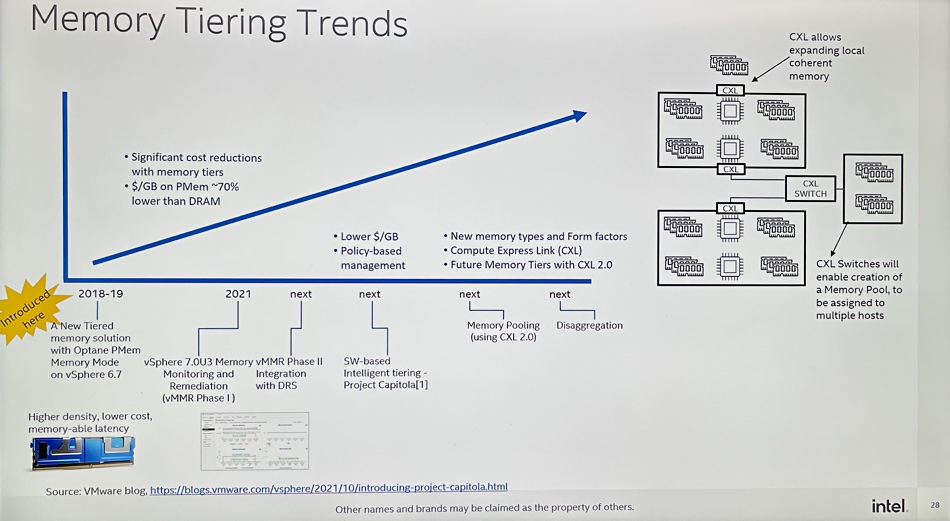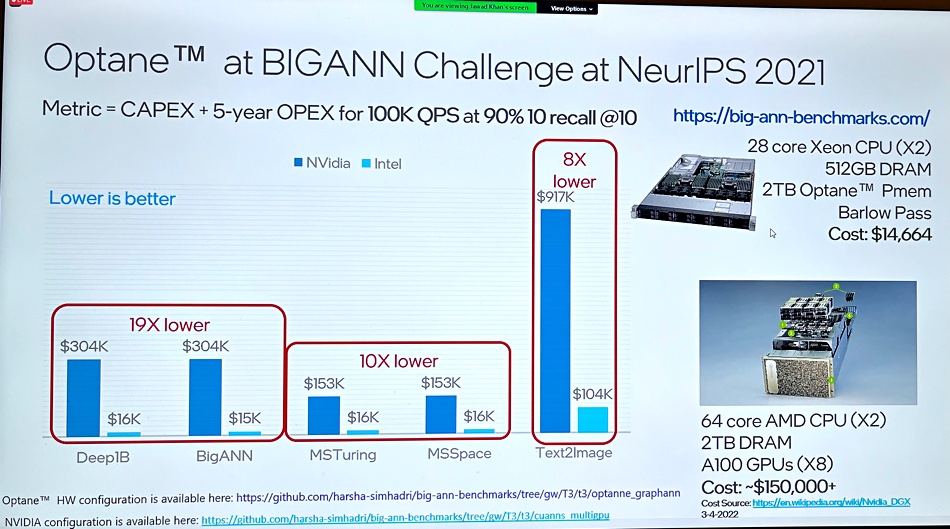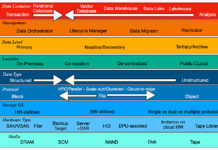Intel will soon announce its third-generation Optane products and is working on another iteration in the series. This was stated by Intel veep Kristie Mann during a Storage Field Day presentation on Friday.
Optane is Intel’s implementation of its 3D XPoint technology, developed initially in partnership with Micron. Last year, Micron exited the business of 3D XPoint chip and drive manufacturing, and sold off its XPoint foundry in Lehi, Utah, which supplied components to Intel. First-generation XPoint was succeeded by generation two, code-named Alder Stream for SSDs and Barlow Pass for persistent memory in 2020.
During the presentation, Mann said Intel is ”about to announce gen 3 and working on the next generation [which] will do CXL Memory tiering.” This marries up with what Intel told us earlier this month. Mann’s team on Friday talked about two new Optane use-cases though added no information about actual gen 2 and 3 Optane products or timescales.

The audience was told that Intel is working closely with VMware on getting vSphere and allied software developed to use Optane persistent memory. Project Capitola was cited, and Intel is working with other hypervisor makers, too. Asked about these partnerships, Intel cloud architecture consultant Flavio Fomin said, “yes, there is a lot happening” outside the VMware world. For him, “tiered memory is the new normal,” meaning DRAM is treated as tier zero memory and Optane persistent memory as tier one.
Hypervisors ought to be tweaked to know about and take advantage of the difference between DRAM and XPoint memory, while application-level code does not need to be altered. We are left to envisage that Microsoft with Hyper-V, Nutanix with AOS, and Red Hat with KVM are all working with Intel on Optane persistent memory support.
Use cases
The first new use-case is an Intel in-house example involving searching data ingested through Kafka and Splunk with the information stored on a VAST Data system with 650TB of Optane SSD and QLC NAND SSD capacity. A search of this data took 29.5 seconds on an HP Ezmeral system using direct-attached SSDs, and 25.1 seconds on Intel’s setup. We note that VAST’s software had reduced the already-compressed Splunk data; the 650TB VAST Box could store more than 1.6PB of Splunk data.
The second use case was large-scale similarity searches, which are used by websites of the Baidu, eBay, Amazon, and YouTube ilk to make recommendations to netizens. This process involves searching billion to trillion-item datasets, with data stored as feature vectors and, separately, graphs. Intel principal engineer Dr Jawad Khan told the presentation’s audience that Intel won a metric in the Billion-Scale Approximate Nearest Neighbor Search Challenge at NeurlPS 2021.

He contrasted a dual-socket 28-core Intel Xeon server fitted with 512GB of DRAM and 2TB of Optane persistent memory, costing $14,664 in street pricing, with an Nvidia A100 GPU-powered server system needing a pair of 64-core AMD host processors with 2TB of DRAM, with the overall system costing around $150,000.
The Optane box was 8 to 19 times lower in cost than the Nvidia system for the same level of performance, or so we were told.
We are left thinking that Intel is still committed to Optane and its 3D XPoint technology, hammering away at extending the ecosystem of supporting partners, and pushing forward with denser gen-3 and -4 XPoint technology. That implies it is making or has made manufacturing plans, and has gen-2 persistent memory and SSD product families planned in some detail and gen-4 equivalents in outline.

We’ll hear more in later this month, or in April, when we expect Crow Pass XPoint products will be unveiled.








